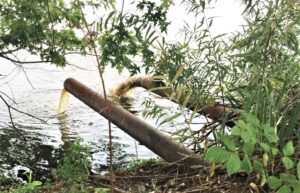BY KATHRYN KELLY
The response by Carol Dungan and Friends of Lake Hiawatha (FOLH), “Sometimes simple is not better,” states that “in the 1950s … Hiawatha gained a following from Black golfers.” That statement is incorrect. Black golfers golfed at Hiawatha as early as the 1930s, according to articles in the Spokesman-Recorder newspaper. Shortly after the golf course opened in 1934, Black golfers started soliciting the Central States tournament for Hiawatha Golf Course. It was a large regional Black tournament that drew Black golfers from all over the Midwest. This tournament was held at Hiawatha Golf Course in 1938. In 1951, Black golfers finally requested equal access to the facilities and privileges at Minneapolis golf courses.

Existing golf course pump discharge
(Photo/Draft Hiawatha Golf Course Area Master Plan)
Regarding the pumping of water from the golf course, my understanding is that the pumping wasn’t started until the 1970s or later. I don’t believe that there was any consistent pumping from the golf course into Lake Hiawatha in the 1950s. But, as the water levels in the lake increased over the years, more and more pumping needed to be done.
FOLH’s response also states that “pumping accelerated in 1992 but was permitted only to remove storm water.” I know of no permit to pump storm water into Lake Hiawatha until 2019. That is when Scott Pearson, the hydrologist at the DNR, told me that the DNR was finally going to require the Park Board to get a dewatering permit for the golf course, which the Park Board did. Regarding the statement about “violation of existing law,” the DNR should be asked why they didn’t enforce the law between 2014 and 2019, if the golf course was violating it.
The FOLH response also says, “At some unknown time, they started pumping 300-400 million gallons of storm water.” I have a whole list of projects that increased the amount of water in the lake and on the golf course, requiring the necessity for pumping more water. In other words, it was not a golf course problem – it was the fact that Lake Hiawatha and Hiawatha Golf Course have been used as a dumping ground for water by the city of Minneapolis and the whole watershed.
The $4 million damage estimate is unsubstantiated. My calculations, using Park Board revenue figures, show a revenue loss of about $560,000, along with the cost of some grass seed and a few equipment repairs. The revenue loss would have been much less if the back nine wasn’t kept closed, apparently to get FEMA money. And please explain why the $1.1 million FEMA award for Hiawatha Golf Course wasn’t used to fix the flood damage at the golf course. Maybe because it wasn’t needed? Most of the FEMA money was spent at Gross and Wirth golf courses. FOLH’s response also said that no FEMA money will be coming for a future flood. It was never needed in the first place, nor was it used to bring the golf course back to playable condition. So that is a moot point.
The trash does not come from the golf course. It comes from the city of Minneapolis storm sewer pipes and Minnehaha Creek. The city of Minneapolis needs to immediately fix its contribution to the problem.
FOLH’s statement about homeowners not being afraid because Commissioner Cathy Abene has given them her assurance is not comforting to me. Studies were done for the original plan which did not include an elevated golf course. I know of no new studies conducted for this new plan, so the Park Board knows nothing about whether the homes will be protected from this drastically different plan. Common sense says that permanently putting fill and water on a flood plain is questionable at best. I have had a lengthy conversation with Commissioner Abene, and nothing she said has allayed my fears for homes in the at-risk neighborhoods.
I agree with FOLH that the design for the property is only an idea that has cost almost $1 million. That’s an expensive idea, and I would have hoped to have more than an idea for that amount of money. And who paid this bill? The golfers. Hiawatha Golf Course had revenue of $1.6 million in 2021 and a profit of $300,000, thanks to the hard work of the staff at the golf course on a miniscule budget. Is this now going to be wasted on more make-work for the Planning Group staff next year? And are the taxpayers of Minneapolis ready to pony up almost $80 million for this project, which is the projected high-end cost in 2022 dollars?
























